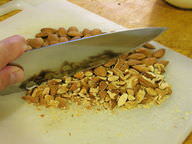13.8 边缘
章节大纲
-
A chisel is a very useful tool for carving wood, rocks, and other hard substances. This man is using a chisel to remove large pieces of wood. A chisel is a type of called a wedge.
::切片是雕刻木头、岩石和其他硬物质的一个非常有用的工具。 这个人正在用切片清除大片木块。 切片是一种叫做切片的工具。What Is A Wedge?
::什么是韦奇?A wedge is simple machine that consists of two inclined planes, giving it a thin end and thick end, as you can see in the Figure . A wedge is used to cut or split apart objects. Force is applied to the thick end of the wedge, and the wedge, in turn, applies force to the object along both of its sloping sides. This force causes the object to split apart.
::织物是简单的机器,由两张倾斜的平面组成,给它一个细端和厚端,如图所示。用织物来切割或分割对象。对厚端的织物施力,而织物又沿着两侧的斜面对对象施力。这种力量使对象分裂。A knife is another example of a wedge. In the Figure , a knife is being used to chop tough pecans. The job is easy to do with the knife because of the wedge shape of the blade. The very thin edge of the blade easily enters and cuts through the pecans.
::刀是另一例。 在图中,刀是用来切碎坚硬的核桃的。由于刀形的刀形,刀很容易操作。刀子的非常薄的边缘很容易通过核桃进入和切开。Mechanical Advantage Of A Wedge
::A前沿的机械优势The of a simple machine is the factor by which it multiplies the force applied to the machine. It is the ratio of the output force to the input force. A wedge applies more force to the object (output force) than the user applies to the wedge (input force), so the mechanical advantage of a wedge is greater than 1. A longer, thinner wedge has a greater mechanical advantage than a shorter, wider wedge. With all wedges, the trade-off is that the output force is applied over a shorter , so force may need to be applied to the wedge repeatedly to push it through the object.
::简单的机器是它乘以机器所应用的力的因素。 这是输出力与输入力之比。 输出力与输入力之比。 输出力对物体( 输出力) 的威力比用户对混合力( 输入力) 的威力要强, 因此一个微小的机器优势大于 1. 较长、 稀小的韦奇拥有更大的机械优势, 而不是更短、 较宽的wedge。 在所有wedge上, 权衡是输出力的威力比更短 , 所以可能需要对最小的威力 施加威力, 以反复的威力将它推穿物体 。Q : Which wedge in the Figure do you think would do the same amount of work with less input force?
::问题:你认为该图中的哪个网点会以较少投入的力量做同样多的工作?A : The wedge on the left has a greater mechanical advantage, so it would do the same amount of work with less input force.
::A:左侧的网点具有更大的机械优势,因此,它以较少的投入力做同样多的工作。Summary
::摘要-
A wedge is a simple machine that consists of two inclined planes, giving it a thin end and thick end. Force is applied to the thick end of the wedge, and the sloping sides of the wedge apply force to the object, cutting it or splitting it apart.
::织物是一种简单的机器,由两架倾斜式飞机组成,给它一个细小的端端和厚厚的端。 将力施于织物的厚端,而织物的斜坡两侧对物体施压,将其切割或分割。 -
A wedge makes work easier by increasing the force applied to the object, although it applies the force over a shorter distance. This gives the wedge a mechanical advantage greater than 1.
::通过增加物体所应用的强度,使工作更容易进行,尽管它能对较短的距离施用力力,这给织物的机械优势大于1。
Review
::回顾-
What is a wedge?
::什么是韦奇? -
How does a wedge change the force applied to it?
::三角形如何改变它所应用的力量? -
Which of the following machines includes a wedge?
-
axe
::轴轴轴 -
hammer
::锤子 -
bolt
::螺栓 -
chisel
::轴轴轴
::以下哪台机器包括一个网形? -
axe
-
Explain why the mechanical advantage of a wedge is greater than 1.
::解释一下为什么一个边缘的机械优势大于1。
-
A wedge is a simple machine that consists of two inclined planes, giving it a thin end and thick end. Force is applied to the thick end of the wedge, and the sloping sides of the wedge apply force to the object, cutting it or splitting it apart.



